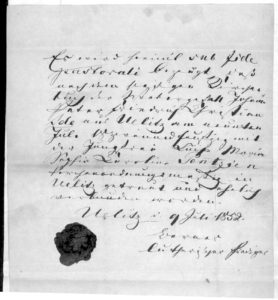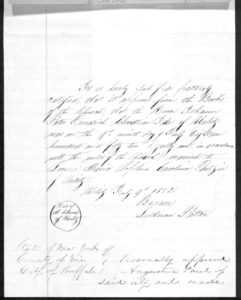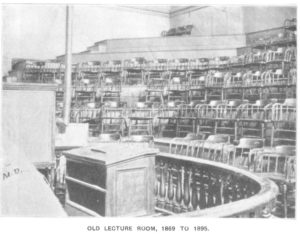Marriage of Christian Ihde and Louisa Pentzien (1852)
10 September 2022
Christian Ihde was mortally wounded in combat near Turner’s Gap on South Mountain in Maryland on 14 September 1862 and died the next day. He was a 37 year old Private in Company I of the 21st New York Infantry and the sole fatality in his regiment in that action.
He left a wife and two small children in Buffalo, NY.
In October 1862 his widow Louisa kicked off the lengthy process – it went through 1868 – to get an Army pension for herself and her kids. The documents which made up that application are at the US National Archives, and thankfully also online via fold3. Following are two tidbits from that pension file.
This is a certificate of her marriage on 9 July 1852 in the village of Uelitz in Mecklenburg, Germany.
It’s in German, of course, and features abysmal penmanship, so I was sure I’d get very little information from it. I was wrong. Two pages later is this English translation – complete with location of the town seal – supplied by Augustus Paul of Buffalo.
One of the best things about this document, now that I know what it says, is that it spells out Christian and Louisa’s full baptismal names, viz, Johann Peter Freidrich Christian Ihde and Louisa Maria Sophia Caroline Pentzien. Fabulous.
Christian, his new bride, and his sister left Germany on a ship for New York 3 weeks after the wedding and were living in Buffalo by 1855.
Drs. Katherine Francis Beatty and George T. Cook
9 September 2022
George Tottingham Cook was seriously wounded at Antietam in September 1862 while First Sergeant of Company C, 21st New York Infantry, and was 2nd Lieutenant of his Company at muster-out in May 1863.
His wound troubled him for the rest of his life.
Disabled for the field but still eager to serve, he was a Lieutenant in the Veteran Reserve Corps (VRC) from 1863 to 1867. Here’s his impressive commission in the VRC signed by President Lincoln and Secretary of War Stanton. It was offered for sale by the Abraham Lincoln Book Shop in Chicago.
He continued in the Army as a Lieutenant in the 6th US Infantry after the War, but resigned, probably for health reasons in 1870.
After a stint in business in his native Buffalo, he got a Government job in Washington, DC in 1881, and from 1882-85 went to medical school in the evenings at Howard University. He probably met his wife Kate there – she graduated from Howard with an MD in 1884, he in 1885 – she almost 20 years his junior.
Here are their capsule biographies and a view of the medical lecture hall from Howard University Medical Department, Washington, DC: A Historical, Biographical, and Statistical Souvenir (1900). It’s online from Howard.
George died at age 50 in February 1891 and an Act of Congress (HR 13971) of March 1891 granted a veteran’s pension to Kate and their daughter Ethel Beatty Cook (1888-1980), citing his Antietam wound as a cause of his death.
Kate lived with Ethel in Washington, DC to her death there in 1928 – making a living as a clerk in the War Department. All three Cooks were buried in Arlington National Cemetery.
Frank’n Averill, Corp’l, N.Y.
8 September 2022
Here’s the gravestone in Antietam National Cemetery for Corporal Franklin Averill of Company H, 21st New York Cavalry. The photograph was shared on his Findagrave memorial by prolific contributor Birdman.
Franklin was wounded at Antietam on 17 September 1862 while a Private in the 21st New York Infantry, but survived to enlist again, in the 21st Cavalry in 1863. That regiment was assigned to the Remount Camp at Cumberland, MD from late August through October 1864, and seem to have had a miserable time there. There were at least three deaths, two civil arrests, and 18 desertions among the men of the regiment during that period.
One of these was Franklin Averill, who was shot by the provost guard in Cumberland and died there on 23 September 1864. The town clerk in Colden, NY later wrote that he
was shot by a picket through carelessness or daring, have been unable to get any further particulars.
I, too, wish I knew more of that story.
Franklin’s remains were removed from Cumberland and reinterred in the new National Cemetery in Sharpsburg in about 1867.







